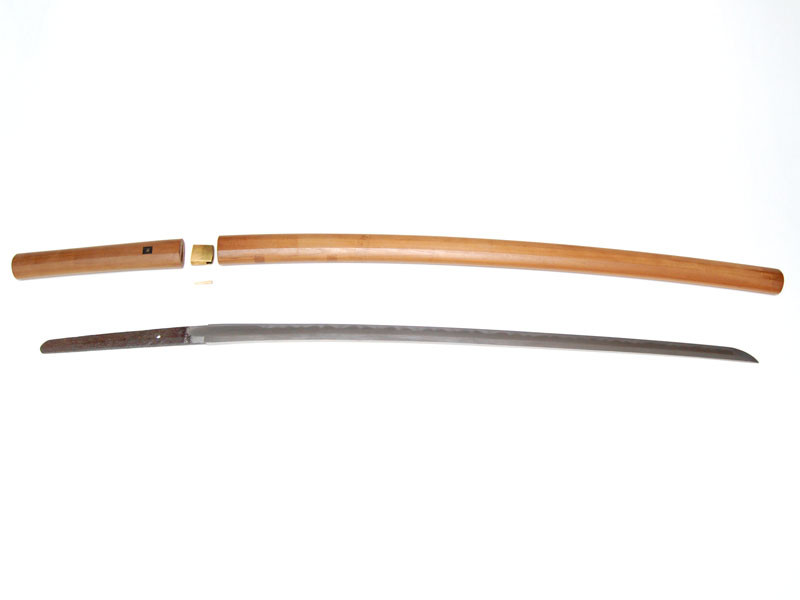




More informations about this product
| Total Weight | 1.00 kg | |
| Weight without Saya | 0.759 kg | |
| Blade Weight | 0.649kg | |
| Full length Naked Blade (Toshin) |
94.35 cm | |
| Nagasa | 72.40 cm | |
| Tsuka Length | 22.8 cm | |
| Sori (curvature) | 1.35 cm | |
| Kissaki Length | 3.5 cm | |
| Moto Haba | 3.0 cm | |
| Saki Haba | 2.03 cm | |
| Moto Kasane | A= 0.63 cm B = 0.67 cm |
|
| Saki Kasane | A= 0.40 cm B = 0.42 cm |
|
| Curvature | Koshi-zori or Moto Zori (Curvature on the first third of the blade, also called Biken Zori or Hiken Zori. |
|
| Type Kissaki | Chu Kissaki (Moyenne length) | |
| Blade Structure | Shinogi zukuri (diamond shaped) Light Funbari (the blade is wider at its basis) |
|
| Mune | Iori mune (Triangular) | |
| Hamon | Toran Ba with 6.5 cm Yaki Dashi typical from Osaka productions. | |
| Hada | Ko Itame (very tight and fine wood veins pattern) | |
| Boshi | Ko Maru Sagari Boshi on the Omote Side (Circular Boshi also called "Osaka Boshi") Kaen Boshi on the Ura side. (Flame shaped Boshi) long return on the Mune level (long Kaeri Boshi) on the 2 sides. |
|
| Nakago | Nakago Ubu (unaltered), with a very oxyded signature on the Omote side. It is shaped a particulary narrow Ichimonji Gata. It ends in Ha Agari Kurijiri (Dissymetrical U), Yasurime not visible (Surface oxydation covering it), Only 1 Mekugi Ana. |
|
| Koshirae | Magnolia made Shirasaya Copper Fuchi Kashira, Horn Mekugi. |
|
| Saya | Shirasaya type Saya, in Japanese Magnolia, length = 77.10cm Weight = 241g |
|
| Tsuka & Tosogu (Tsuba, Menuki, Fuchi Kashira) |
- Shirasaya Tsuka type made of Japanese Magnolia, Black horn reinforced Mekugi Ana, length = 22.8cm, Weight = 76g - Gilded copper Habaki with Neko Gashi "Cat Claws" in a diagonal pattern. Weight 31g |
|
| Study & Team Review |
Shizuhiro "鎮弘" Iga Area, Mie Prefecture Shizuhiro "鎮弘" : There were 2 generations of Shizuhiro, respectively during Kanbun Era (1661-1673), and during Genroku Era (1688-1704). Both were from Iga area and Iga-Isshido school. This school is issued from the Buno-Takada School, performing in the Iga area. The Shizutada and Shizumasa brothers are considered as the ancestors of their group. They were active starting from Kan'ei Era (1624-1644), Shizumasa being the elder brother. Orignated from Bungo Takada, they settled quite lately in Nabari, Iga area. It is writtent that Shizutada did first settle in Kii to study the Ishido school. Considering their origin and their relationship with the Ishido school, their group is named "Nabari Takada" or "Iga-Ishido". Shizutada's work was similar to Kyomitsu's from Sue-Bizen school. Shizutada's second generation was active during Kanbun Era (1661-1673), and were also named with the honorifical title of "Hizen no Kami". Then come the 2 Shizuhiro generations, the first being the one that made this magnificent Katana. Iga : Nowadays in Mie prefecture, Iga is a known area for its mountains making it hardly reachable by any road. This area is also known for being the home for "Ninja", as were its nearby neighbour, the Koga area. actuellement dans la préfecture de Mie, Iga est une province connue pour ses montagnes qui la rendait difficilement accessible par la route. Cette province est aussi connue pour être le lieu de naissance des "Ninja", avec sa province voisine Koga. Team Review : Very nice mirror polishing. There is 2 light Kisu (very slight openings on the steel folding) on the Mune, the first one 20cm from the Mune Machi, the second one 8cm from the Ha Machi (on the edge of the Ha and Jigane). These openings are classical for such ancient blades. Very small oydation point on the Kissaki, on the Omote side. The fineness of the Blade is typical for Hizen, making it very nice holding it and using it, added the fact it has a very nice balance. |
|
Share your opinion
error Your review appreciation cannot be sent
feedback Report comment
check_circle Report sent
error Your report cannot be sent